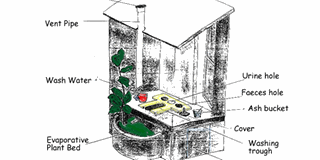How it works: Ecosan toilet

The Minister for Water and Environment, Maria Mutagamba, recently decried the traditional pit latrine and its impact on the environment. She said besides having to dig deep into the ground for these types of toilet and the attendant risks such as the holes caving in either during excavation or during use, there is the danger of polluting groundwater with human waste.
At another occasion, a career fair during a workshop for East African water professionals held in Kampala last week, she blamed the high level of unemployment among youth on a lack of skills but also pointed out that there were several opportunities in the water sector to improve service delivery.
One of the methods that help answer both these concerns includes the ecosan toilet because it answers the points that the minister has raised.
The principle
Ecosan is the shortened form of ecological sanitation, a school of thought and a form of technology which looks at human waste and wastewater as an opportunity. The basic principle is to reduce health risks of contaminated water and to use the nutrients in urine and excreta beneficially to improve soil fertility or the left-over dry matter as biofuel.
Well designed and operated ecosan systems provide a hygienically safe and economical way to do this. The set up requires skills which can be imparted to the youth as part of a programme to spread the technology in different parts of the country, and the manure and dry matter for bio-fuel generated can be a source of income as it can be sold to those that need it. Thus, ecosan toilet can open up opportunities for job opportunities and income generation while simultaneously protecting the environment.
The ecosan toilet comprises one or two chambers, a pit that does not exceed two metres deep which is sealed with concrete to prevent contact between excreta and soil, a separate pipe for urine, and a vent pipe to trap flies and other insects, and lids on the side, front or back to remove the composted matter.
There are several designs but all use composting as a way to break the waste. It uses rapid aerobic (using oxygen) composting in which bacteria that thrive at high temperatures oxidise (break down) the waste into its components, some of which are consumed in the process, reducing volume and eliminating harmful germs.
Drainage of liquid via a separate drain is featured in some units, as the aerobic composting process requires moisture levels to be controlled: too dry—and the mass decomposes slowly or not at all; too wet—and anaerobic organisms thrive (where there is no oxygen), creating undesirable odours. This separated liquid may be diverted to another system or collected for other uses. Where solar heat is used, this might be called a “solar” toilet. These systems depend on desiccation to achieve sanitation safety goals and features systems that make use of the separated liquid fraction for immediate area fertilisation.
Urine can contain up to 90 per cent of the nitrogen, up to 50 per cent of the phosphorus and up to 70 per cent of the potassium present in human excreta. In healthy individuals, it is usually free of germs, although undiluted it may contain levels of inorganic salts and organic compounds at levels toxic to plants.
Important factor
The other requirement critical for microbial action (as well as drying) is oxygen. These systems provide methods of ventilation that move air from the room, through the waste container, and out a vertical pipe, venting above the enclosure roof. This air movement expels carbon dioxide and odours.
Such a toilet treats excreta, typically with no water or small volumes of flush water via composting or managed aerobic decomposition.
Composting toilets may be used as an alternative to flush toilets in situations where there is no suitable water supply or waste treatment facility available or to capture nutrients in human excreta as humanure.
The human excrement is normally mixed with sawdust, or ash for instance to support aerobic processing, absorb liquids, and to reduce the odour. The decomposition process is generally faster than the anaerobic decomposition used in wet sewage treatment systems such as septic tanks.




